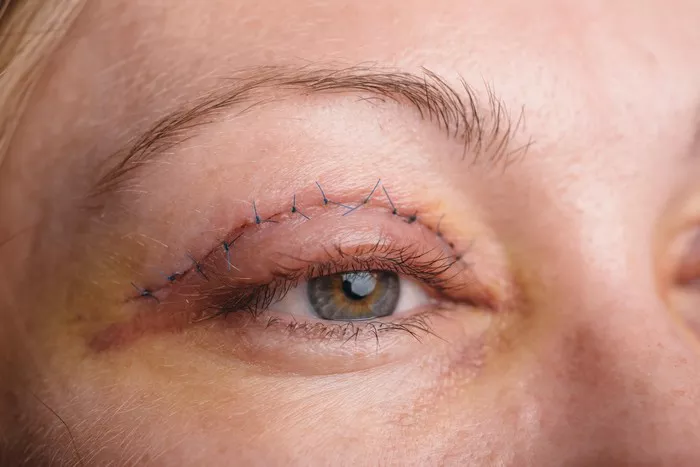Upper eyelid surgery, also known as blepharoplasty, is a cosmetic procedure that aims to enhance the appearance of the upper eyelids by removing excess skin and fat. If you’re considering this surgery, one common concern you may have is whether it leaves scars. This article aims to provide you with a comprehensive guide to help you understand what to expect in terms of scarring after upper eyelid surgery.
Understanding Upper Eyelid Surgery
Upper eyelid surgery is a surgical procedure performed to address cosmetic concerns and functional issues associated with the upper eyelids. It can help reduce drooping, puffiness, and the appearance of tired or aged eyes. During the procedure, an incision is made along the natural crease of the eyelid, allowing the surgeon to remove excess skin and fat. The incision is then meticulously closed with fine sutures.
Location and Type of Incisions
The location and type of incisions made during upper eyelid surgery play a crucial role in determining the visibility of scars. The primary goal is to place the incisions in inconspicuous areas, such as the natural crease of the eyelid, to minimize visible scarring. The following are the common incision techniques used in upper eyelid surgery:
-
Full Incision Technique
This technique involves creating an incision along the entire length of the upper eyelid crease. The advantage of this approach is that it allows for maximum access to remove excess skin and fat. While the scar may initially appear more prominent, it usually fades over time and becomes less noticeable.
-
Short Incision Technique
In cases where minimal correction is required, a shorter incision technique may be used. This involves making a smaller incision within the natural crease of the eyelid, focusing on the area where excess skin needs to be removed. The scar resulting from this technique is typically shorter in length and more discreet.
-
Transconjunctival Technique
In some instances, upper eyelid surgery may be performed using a transconjunctival approach. This technique involves making an incision inside the lower eyelid, allowing access to remove or reposition fat without visible external scarring. This technique is particularly suitable for patients with minimal excess skin and who primarily require fat removal or repositioning.
Scarring and Scar Healing Process
It’s important to understand that whenever an incision is made, there will be some degree of scarring. However, the visibility of scars can vary significantly depending on various factors, including individual healing characteristics, surgical technique, and proper scar care.
After upper eyelid surgery, the incisions will initially appear as red or pink lines. Over time, the scars typically undergo a healing process, gradually fading and becoming less noticeable. The scar healing process can take several months to a year or more.
During the first few weeks following surgery, it’s normal for the scars to appear more noticeable and possibly slightly raised or lumpy. This is part of the normal healing process and can be managed with proper scar care techniques.
Minimizing Scarring and Promoting Scar Healing
While complete scar elimination is not possible, there are steps you can take to minimize scarring and promote optimal scar healing after upper eyelid surgery. Here are some helpful tips:
- Follow Your Surgeon’s Instructions: Your surgeon will provide you with specific post-operative care instructions. It’s crucial to follow these guidelines diligently to promote proper healing and minimize the risk of complications.
- Keep Incisions Clean and Moisturized: Proper wound care is essential to optimize scar healing. Gently cleanse the incisions as instructed by your surgeon and apply recommended ointments or moisturizers to keep the area hydrated.
- Protect from Sun Exposure: Direct sunlight can cause scars to become darker and more noticeable. Protect the incision sites from sun exposure by wearing sunglasses, a wide-brimmed hat, or using sunscreen with a high SPF.
- Avoid Irritants: During the healing process, it’s important to avoid irritants such as harsh soaps, chemical-based skincare products, or excessive rubbing or scratching of the incisions. These can hinder proper scar healing.
- Be Patient: Scar healing is a gradual process that takes time. It’s important to be patient and allow your body to heal naturally. With time, the scars will fade and become less visible.
Consulting with a Qualified Surgeon
If you’re considering upper eyelid surgery, it’s crucial to consult with a qualified and experienced plastic surgeon. A skilled surgeon will assess your specific case, discuss the surgical techniques they recommend, and provide you with detailed information about scarring and scar healing expectations.
Remember, while some scarring is inevitable with any surgical procedure, proper technique, post-operative care, and patience can significantly minimize the visibility of scars over time. Ultimately, the benefits of upper eyelid surgery in improving your appearance and self-confidence often outweigh the potential for minimal scarring.

